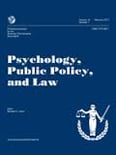 Interview style may impact detection of deception This is the bottom line of a recently published article in Psychology, Public Policy, and Law. Below is a summary of the research and findings as well as a translation of this research into practice.
Interview style may impact detection of deception This is the bottom line of a recently published article in Psychology, Public Policy, and Law. Below is a summary of the research and findings as well as a translation of this research into practice.

Featured Article | Psychology, Public Policy, and Law Vol. 23, No. 3, 301–311
Police Officers’ Ability to Detect Lies Within a Deception Paradigm
Authors
Taeko Wachi, National Research Institute of Police Science, Kashiwa, Chiba, Japan
Hiroki Kuraishi, National Research Institute of Police Science, Kashiwa, Chiba, Japan
Kazumi Watanabe, National Research Institute of Police Science, Kashiwa, Chiba, Japan
Yusuke Otsuka, National Research Institute of Police Science, Kashiwa, Chiba, Japan
Kaeko Yokota, National Research Institute of Police Science, Kashiwa, Chiba, Japan
Michael E. Lamb, University of Cambridge
Abstract
This study aimed to examine police officers’ accuracy in classifying guilty and innocent participants using 3 interviewing styles (evidence-focused, relationship-focused, and control). In a modified version of Russano, Meissner, Narchet, and Kassin’s deception paradigm, participants who had violated a rule (i.e., cheating while solving problems) were considered guilty, whereas those who had followed the rule were considered innocent. After interviewing 234 adult men, 11 experienced male police officers accurately classified over 90% of them as guilty or innocent. Of 160 participants who did not admit to cheating, 140 (87.5%) were correctly classified. There was no statistically significant relationship between interviewing style and police officers’ identifications of guilty deniers (i.e., liars) and innocent deniers (truth tellers). However, interviewers were more likely to believe guilty deniers in the evidence focused condition, and they tended to believe innocent deniers in the relationship-focused condition. These findings suggest that the ability to detect deception might be influenced by interviewing style.
Keywords
detecting deception, verbal cues, confidence, interviewing style
Summary of the Research
“Numerous researchers have examined the ability of professional lie catchers, mainly police officers, to detect deception. In a review of 28 English-language studies, Vrij (2008) reported that most police officers sought to detect interviewees’ lies through observation, and that the average overall accuracy rate was 55.9% (range 40%–73%)” (p. 301).
“In another review of 79 studies exploring the lie-detection ability of laypersons (mainly university students), Vrij reported an average total accuracy rate of 54.3% (range 31%–68%). Further, in 34 studies reporting truth accuracy rates and lie accuracy rates of laypersons separately, the former and latter were 63.4% and 48.2%, respectively. The research thus suggests that professional lie catchers are not necessarily better lie detectors than laypersons, and that lay- persons are more likely than professionals to exhibit a “truth bias” (i.e., a tendency to believe that interviewees are telling the truth “ (p. 301).
“Some studies have demonstrated that more experience negatively affects the ability of police officers to detect deception. For example, Meissner and Kassin (2002) reviewed six studies and conducted original research on this topic. They found no significant association between the ability to detect deceit and prior interviewing experience and training. In fact, interviewers who had prior experience and training were more likely to exhibit a “lie- bias” (i.e., tendency to consider interviewees as deceitful) than were those without prior experience and training” (p. 301).
“By conducting more ecologically valid experiments, Mann, Vrij, and Bull (2004) and Vrij, Mann, Robbins, and Robinson (2006) reported more accurate lie detection than in most of the studies reviewed by Vrij (2008). Both studies involved police officers who were shown real-life video clips of actual suspects being inter-viewed; they were asked to judge the veracity of the suspects and rate their levels of confidence. Compared with the studies re-viewed by Vrij (2008), “the stakes” (i.e., positive consequences of getting away with the lie and negative consequences of getting caught; Vrij et al., 2006, p. 742) in their studies were higher. Mann et al. (2004) reported an average lie accuracy rate of 66.2% and average truth accuracy rate of 63.6%, significantly higher than chance level (50%). Unlike Meissner and Kassin, Mann showed positive correlations between accuracy rate and police officers’ levels of experience” (p. 301).
“The current study examined the effectiveness of the three conditions of interviewing styles, namely, evidence-focused, relationship-focused and control interview conditions on police officers’ ability to detect deceit. These three interview styles were based on the results of a survey of Japanese police officers on suspect interviews. In the evidence-focused interview, the interviewer obtained a free narrative about the mock event from the participants (mock suspects), followed by providing two pieces of evidence item by item, a procedure similar to Dando and Bull’s gradual revelation of information. In the relationship-focused interview, the interviewer attempted to build rapport with participants by talking about the participants’ job experience and so on prior to asking the mock event. Those in the control interview did not use any special techniques” (p. 302).
“Participants were recruited through Internet advertisements or e-mail solicitations by recruitment agencies. Participants were required to be 20- to 50-year-old men, without mental or physical limitations, who could communicate in Japanese. The mean age of the 234 participants was 31.50 years (SD 8.66; range 20 –50 years). Fifty participants (21.4%) were vocational, undergraduate, or postgraduate students. More than half (136; 58.1%) of the participants were employed (including 86 part-time workers) and 40 (17.1%) were unemployed” (p. 303).
“The interviewers were 11 male police officers who had been seconded to the National Police Agency of Japan from prefectural police headquarters. The interviewers’ mean age was 41.91 years (SD 6.61; range 34–53 years). Three interviewers were superintendents, seven were chief inspectors, and one was an inspector. The mean numbers of months of experience for police officers and detectives, respectively, were 243.27 months (SD 95.98) and 122.91 months (SD 96.00)” (p. 303).
“During the individual problem-solving phase, the confederate first asked the ending time and then tempted the participant to give him or her the answer to the final question (i.e., by asking for the number of triangles in a diagram) and thus effectively break the stated rule. The confederate spoke to the participant only when he or she noticed that the participant had written the answer to the final question. If the participant told the confederate his answer, the participant was regarded as guilty. If the participant refused to tell the confederate, the participant was regarded as innocent” (p. 303).
“Interviewers were quite good at assessing the participants’ veracity, with more than 90% of them correctly classified. Even when participants denied wrongdoing, 140 (87.5%) of the 160 participants were correctly classified. These percentages were above chance level and inconsistent with those found in previous studies in which lie detectors (observers) were professional inter- viewers (55.9% in Vrij, 2008)” (p. 308).
“This study employed an ecologically valid paradigm and demonstrated a higher rate of classifying guilty and innocent participants by experienced police officers, partly because they knew the factual truth and obtained free narratives from the mock suspects at the beginning of the interview. They also relied on verbal responses when judging the suspects’ veracity accurately. Although we failed to find an effect of interview styles on the interviewers’ veracity judgment, interviewers’ opinions about whether the mock suspects were telling the truth were influenced by the interviewing style. Notably, the interviewers in the evidence-focused condition were more likely to believe that guilty deniers (i.e., liars) were telling the truth” (p. 310).
Translating Research into Practice
“These results have important implications for police practice. Generally, the police are in possession of some factual evidence when investigating a crime. Therefore, police officers are required to first listen to suspects’ accounts and compare their accounts to the factual evidence, whether or not they confront suspects using this, which can increase both truth and lie detection accuracy rates. Even conversations unrelated to the crime when building rapport with suspects can be useful because the suspects’ responses and behaviors during these conversations can be compared with those evident while talking about the crime itself” (p. 310).
Other Interesting Tidbits for Researchers and Clinicians
“Findings also suggest that confronting suspects with evidence should be accomplished cautiously. It is important not to believe suspects too readily even when they refuse firmly. Further evidence and investigation by the police force is needed to confirm whether suspects are really telling the truth” (p. 310).
Join the Discussion
As always, please join the discussion below if you have thoughts or comments to add!





















